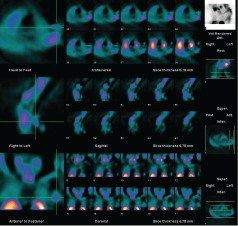Review of raw data cine mode is essential in the interpretation of myocardial perfusion SPECT imaging (MPI) for not only distinguishing the potential artifacts but also giving further diagnostic information by identifying incidental non-cardiac uptakes. Here, we report an incidental finding of invasive breast carcinoma detected during MPI cine mode.
A 67-year-old woman without known coronary artery disease (CAD) was referred to our department for the evaluation of atypical left-sided chest pain. She had typical atherosclerotic risk factors such as diabetes mellitus, hypertension and dyslipidemia. Patient underwent MPI with one-day Tc99m sestamibi stress/rest protocol with exercise stress test. Evaluation of stress MPI images presented no perfusion defect in the left ventricle. However, evaluation of the raw data in cine mode showed 2 sestamibi foci in the upper external quadrant of the left breast (Figure 1a and Video 1). The SPECT images in three planes clearly displayed focal breast uptakes and their association with the heart (Figure 2). The patient denied any history of malignancy, or any evidence of breast pathology in her past medical history. Ultrasonography showed that spiculated irregular mass lesion with central necrotic degeneration at the left upper quadrant of the left breast. The consequent mammography revealed a focal asymmetric high-density mass at the 2 o'clock position, pectoral extension also reported (Figure 1b). Additionally, multiple axillary lymphatic nodes were noticed. All of these findings were reported as "highly suggestive of malignancy" (aka BI-RADS 5). Subsequently, ultrasound-guided core needle biopsy was performed. The diagnosis was invasive ductal carcinoma and the patient was referred to an oncology clinic for further therapies.
The incidence of non-cardiac findings in MPI is reported to be between 0.68% and 1.7% [1]. Though the incidence is very low, evaluation of raw data images in cine mode is highly recommended owing to the fact that it may lead to the detection of potentially important incidental findings that can change the patient management. Frequently used myocardial perfusion agents are also known with their tumoral avidity and regarding this fact; focal extracardiac radioactivity uptakes in breast or lung are usually considered as a high probability for malignancy. Scintimammography by sestamibi has been used as a method for the detection of breast cancer [2]. Nevertheless, false-positive results had been reported due to fibroadenoma, fibrocystic disease, focal atypical hyperplasia, granuloma, papilloma, breast involution, sclerosing adenosis, hematoma, focal inflammatory reaction (scarring, mastitis, and foreign mass reaction), benign angiomyoepithelioma, gynecomastia, pitfalls of interpretation, and even in the normal breast tissue [3-7].
Although sestamibi is an important tumor-screening agent, extracardiac findings on MPI may be readily missed out and requires an attentive look to extracardiac findings, which may provide a valuable tool for the detection of potentially important incidental pathologies. As a result, any clearly visible extracardiac uptake seen on the cine mode, particularly focal sestamibi uptakes in the breast tissue that may issue for their higher malignancy potential, should be followed up clinically.
All the authors, namely Aylin Akbulut, Suleyman Kalayci, Gokhan Koca, Meliha Korkmaz declare that they have no conflict of interest. The authors have not used any sources of public or private financial support.
All procedures performed in studies involving human participants were in accordance with the ethical standards of the institutional and/or national research committee and with the 1964 Helsinki declaration and its later amendments or comparable ethical standards.
The institutional review board of our institute approved this case study, and the requirement to obtain informed consent was waived.
None.

Figure 1: a) Raw data of rest MPI demonstrating clearly visible 2 foci of sestamibi; b) The left mammographic image of the mass is shown with arrows.

Figure 2: The breast lesion is shown in axial, sagittal, coronal planes of MPI.
Video 1: Rotating raw data cine images showing breast lesions.